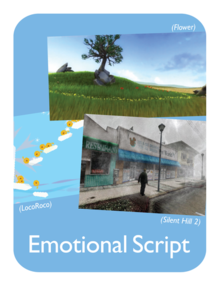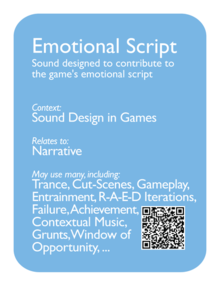Difference between revisions of "Emotional Script"
ValterAlves (Talk | contribs) m |
ValterAlves (Talk | contribs) m |
||
| Line 32: | Line 32: | ||
| ex3=<mt p="EmotionalScript" g="Ice Age 3" w="{{ViPhoneH}}" h="{{ViPhoneW}}"></mt> | | ex3=<mt p="EmotionalScript" g="Ice Age 3" w="{{ViPhoneH}}" h="{{ViPhoneW}}"></mt> | ||
| ex4=<mt p="EmotionalScript" g="Papa Sangre" w="{{ViPhoneH}}" h="{{ViPhoneW}}"></mt> | | ex4=<mt p="EmotionalScript" g="Papa Sangre" w="{{ViPhoneH}}" h="{{ViPhoneW}}"></mt> | ||
| − | | ex5=<mt p="EmotionalScript" g="LocoRoco" altg="Loco Roco" w="{{R16by9W}}" h="{{R16by9H}}"> | + | | ex5=<mt p="EmotionalScript" g="LocoRoco" altg="Loco Roco" w="{{R16by9W}}" h="{{R16by9H}}">In the example a moment of relative affliction emphasized by the utterances of the characters involved. In general, sound design in this game is highly emotive, for each contribute aspects such as the [[Music]], all [[Character Soundprint|Character's Soundprint]], the way sound participates in the [[Gameplay]], the overall [[Aesthetics]] and [[Variety]] coherency in the [[Acoustic Ecology]].</mt> |
| ex6=<mt p="EmotionalScript" g="Ico" w="{{RPS2W}}" h="{{RIcoH}}"></mt> | | ex6=<mt p="EmotionalScript" g="Ico" w="{{RPS2W}}" h="{{RIcoH}}"></mt> | ||
<!--| ex7=<mt p="EmotionalScript" g="Silent Hill 2" h="200">{{Pending|}}</mt>--> | <!--| ex7=<mt p="EmotionalScript" g="Silent Hill 2" h="200">{{Pending|}}</mt>--> | ||
}} | }} | ||
Revision as of 23:00, 18 October 2011

|

| |
| The card's front face | The card's back face |
Synopsis
| Sound designed to contribute to the game’s emotional script. |
Relationships
Context:
Sound Design in Games ![]() .
.
Relates to:
Narrative ![]() .
.
May use many, including:
Trance ![]() , Cut-Scenes File:M385px-Cut-Scenes-front-v20.png, Gameplay File:M385px-Gameplay-front-v20.png, Entrainment
, Cut-Scenes File:M385px-Cut-Scenes-front-v20.png, Gameplay File:M385px-Gameplay-front-v20.png, Entrainment ![]() , R-A-E-D Iterations
, R-A-E-D Iterations ![]() , Failure
, Failure ![]() , Achievement
, Achievement ![]() , Contextual Music
, Contextual Music ![]() , Grunts
, Grunts ![]() , Window of Opportunity
, Window of Opportunity ![]() , ....
, ....
Description
A game "experience" is built upon the memory of the emotions the player visits. In order to optimize the emotional relevance of every moment the player is interacting with the game product, an Emotional Script ought to be thoughtfully designed.
Sound explorations hold great potential in the design of the Emotional Script.
In addition to the comprehensive exploration that this pattern suggests, the Deck contains some other design patters which may also contribute to some of the pieces in that Emotional Script. Depending on the specific design explorations of the patterns in stake, those may include: satisfaction (e.g. Achievement), disappointment (e.g. Failure, Death), excitement (e.g. Engagement), tension (e.g. Anticipation, Engagement, Imminent Death, Hurry Up!, Window of Opportunity, Silence), serenity (e.g. Relaxation, Trance), anxiety (e.g. Silence, Noise), fear (e.g. Breath, Heartbeat), emphaty (e.g. Ouch!, Grunts, Thoughts), relieve (e.g. Decay), interest (e.g. Awareness), affection (e.g. Make Sound not War), etc.
[pending: classification inspired in EARL [REF: http://emotion-research.net/projects/humaine/earl]]
Examples
  Flower: The game propitiates a journey from the sadness of a polluted and lifeless environment to the pleasure and contentment of recovering it. This happens both at the macro level (observable for instance in the evolution of the Acoustic Ecology that accompanies the Menu) and inside each particular level where each small contribution represents and advancement in an acoustic composition, occasionally further animated by some bursts (both acoustic and visual).
|
  Loco Roco: In the example a moment of relative affliction emphasized by the utterances of the characters involved. In general, sound design in this game is highly emotive, for each contribute aspects such as the Music, all Character's Soundprint, the way sound participates in the Gameplay, the overall Aesthetics and Variety coherency in the Acoustic Ecology.
|
External Resources
References to the importance of emotions in human performance



